Wind Power
We've used the wind as an energy source for a long time.
The Babylonians and Chinese were using wind power to pump water for irrigating crops 4,000 years ago, and sailing boats were around long before that.
Wind power was used in the Middle Ages, in Europe, to grind corn, which is where the term "windmill" comes from.
How Wind Power Energy works/ Wind Power Plant
The Sun heats our atmosphere unevenly, so some patches become warmer than others.These warm patches of air rise, other air blows in to replace them - and we feel a wind blowing.
We can use the energy in the wind by building a tall tower, with a large propellor on the top.
The wind blows the propellor round, which turns a generator to produce electricity.
We tend to build many of these towers together, to make a "wind farm" and produce more electricity.
The more towers, the more wind, and the larger the propellors, the more electricity we can make.
It's only worth building wind farms in places that have strong, steady winds, although boats and caravans increasingly have small wind generators to help keep their batteries charged.
The best places for wind farms are in coastal areas, at the tops of rounded hills, open plains and gaps in mountains - places where the wind is strong and reliable. Some are offshore.
To be worthwhile, you need an average wind speed of around 25 km/h. Most wind farms in the UK are in Cornwall or Wales.
Isolated places such as farms may have their own wind generators. In California, several "wind farms" supply electricity to homes around Los Angeles.
The propellors are large, to extract energy from the largest possible volume of air. The blades can be angled to "fine" or "coarse" pitch, to cope with varying wind speeds, and the generator and propellor can turn to face the wind wherever it comes from. Some designs use vertical turbines, which don't need to be turned to face the wind.
The towers are tall, to get the propellors as high as possible, up to where the wind is stronger. This means that the land beneath can still be used for farming.
Advantages Of Wind Power
1 Wind is free, wind farms need no fuel.2 Produces no waste or greenhouse gases.
3 The land beneath can usually still be used for farming.
4 Wind farms can be tourist attractions.
5 A good method of supplying energy to remote areas.
Disadvantages Of Wind Power
1 The wind is not always predictable - some days have no wind.2 Suitable areas for wind farms are often near the coast, where land is expensive.
3 Some people feel that covering the landscape with these towers is unsightly.
4 Can kill birds - migrating flocks tend to like strong winds.
However, this is rare, and we tend not to build wind farms on migratory routes anyway.
5 Can affect television reception if you live nearby.
6 Can be noisy. Wind generators have a reputation for making a constant, low, "swooshing" noise day and night, which can drive you nuts.
Having said that, as aerodynamic designs have improved modern wind farms are much quieter. A lot quieter than, say, a fossil fuel power station; and wind farms tend not to be close to residential areas anyway. The small modern wind generators used on boats and caravans make hardly any sound at all.










0 comments:
Post a Comment